Features
From abolishing the Senate to adopting a third new constitution
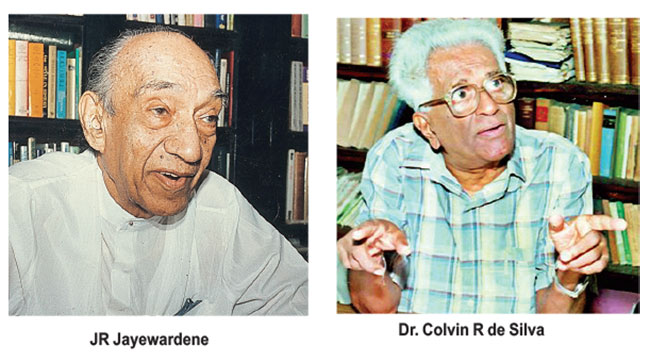
The 50-year Constitutional Odyssey:
by Rajan Philips
There are three infliction and, perhaps also, inflection points to this article. First, is the sequel to my article two weeks ago (Sunday Island, October 10) where I alluded to the possibility of Sri Lanka’s parliament restoring itself and changing the ways of the regime between now and the next elections. In a situation of unprecedented crises, changing the ways of the regime is more vital than waiting for a potential electoral regime change three years from now. That was my plea, if not contention. I did not write last week, so it is carryover business this week. It is also the first point of infliction on the always indulgent editor and the more ageing than ageless readers of English newspapers.
The second point emanates from the visit (also on October 10) by President Gotabaya Rajapaksa to the Gajaba Regiment Headquarters, at Saliyapura, Anuradhapura, to commemorate the 72nd Anniversary of the Sri Lankan Army. In his speech to mark the military occasion, President Rajapaksa included a promissory note on the Constitution, that he will be “bringing in (of) a new Constitution,” as he had promised in November 2019, and that it “will be delivered within the next year.” The President’s obiter of reassurance literally took away the wind out of whatever parliamentary reform sails that I might have been hoping to use for my unsolicited purpose.
The third and the most obviously inflexion point, thanks entirely to Dr. Nihal Jayawickrama and the article he wrote last Sunday (October 17), is the 50th anniversary of the death, on October 2, 1971, of the Senate of Ceylon at the young age of 24. It was death by legislative euthanasia, brutally premature at so young an age and for a body that bore no incurable ill. It was a rather bad riddance of a good body.
Dr. Jayawickrama’s commemorative piece is quite remarkable at many levels. He neither asserts that the Senate deserves what it got, nor is he patently critical that it was put down at all. He is fair in his account of the purpose for which the Senate was created and the manner in which it played its constitutionally assigned role despite its lopsided composition and nominating procedure. He does not cite Sir Ivor Jennings’s scholarly cynicism that an unelected Senate can only be either “mischievous” (when it goes against the elected House) or “superfluous” (when it passes what has already been passed by the House); nor does he refer to Dr. Colvin R de Silva’s forceful contention that the Senate that “frustrates the will of the people” was one of the “five major defects” of the Soulbury Constitution.
That contention alone was enough to indicate the Senate’s fate in the new constitution that was being prepared by the United Front government. What came as a surprise at that time was the manner of the Senate’s riddance by an amendment to the Soulbury Constitution rather than through the new constitution. What struck me in the story of that riddance recounted by Dr. Jayawickrama was the pattern of disownment by all the key players in the parliamentary drama that began with a Bill to amend the Soulbury Constitution to save the SLFP MP for Ratnapura, Nanda Ellawala, from expulsion over a conviction and imprisonment, and ended with a Bill to amend the same constitution to abolish the Senate. To wit, Dr. Colvin R de Silva who introduced the first Bill in parliament, in July 1970, made it a point to ‘disown’ the bill by indicating that the Bill had been drafted in the Ministry of Justice and not by ‘his’ Ministry of Constitutional Affairs. And the disclaimers continued even as the Senate was let to die.
Committee of Experts
Nihal Jayawickrama’s article also provides a foil for contrasting the current urge to create a new constitution with the circumstances 50 years ago when Sri Lanka began its long odyssey of constitutional makeovers. No one would have thought then that it would come this far and could go still further. His intervention is particularly striking because he might be the only person alive who was closest to the making of the First Republican Constitution of 1972. He is also expertly familiar with the genesis and entrenchment of the 1978 Constitution. And perhaps the only other constitutional scholar of the same vintage is Prof. Savitri Goonesekere. If I am not mistaken, I do not think there is anyone alive today, who was associated with the making of the 1978 Constitution.
On the other hand, and I do not say this to be uncharitable, in President in Gotabaya Rajapaksa, we have the first Sri Lankan to become the most powerful person in the country with the least familiarity with anything constitutional. And it gets worse. In 1970, Parliament was the master of the country’s constitutional destiny, not only by representation but also by virtue of its legal luminaries. The finest legal minds in the country were in parliament, with the House and the Senate combined. Today’s parliament is not only bereft of talent, but is also powerless in spite of the government’s two-thirds majority. Worse, it is totally sidelined from the making of the new constitution.
That task has been outsourced to a committee of experts none of whom are in parliament, or ever held any elected office. Without tracing the bio-data of individual committee members, I will not be too far off the mark to suggest that with the exception of Prof. GH Pieris, all the other members of the committee would have been in their early twenties at most when Sri Lanka began its constitutional odyssey in 1970. If they were all kids then, they would do well to read Dr. Jayawickrama’s article on the Senate and reflect on what they are about to do now as grownups in creating a new constitution for President Gotabaya Rajapaksa.
If they are also keeners, and they ought to be so to be considered ‘experts’, it is reasonable to assume that they would have by now had some discussions with Dr. Jayawickrama to benefit from his experience and expertise. If not, it’s a shame. It is a travesty that this government is hellbent on creating a new constitution without consulting with or getting advice from people like Prof. Savitri Goonesekere or Dr. Nihal Jayawickrama. Travesty though it is, it should not come as a surprise to anyone considering the way the government availed itself of expert advice on Covid-19.
The impetus for the constitutional change in 1970-72 came from a side remark (obiter) in a 1964 Privy Council ruling that highlighted the legislative limitations of the Sri Lankan (then Ceylon) parliament. Although the contentious Privy Council obiter had been around since 1964, it became a political issue in parliament only in 1969, and it became an election issue in the April 1970 elections. The landslide victory of the United Front Parties in 1970 and the appointment of Dr. Colvin R de Silva as Minister of Constitutional Affairs eventually led to Sri Lanka becoming a Republic with a new constitution in 1972.
The inspiration for the 1978 constitutional overhaul came almost entirely from JR Jayewardene’s idiosyncratic liking for a presidential system of government. He was fortuitously able to use the flexibility of the Colvin constitution to create a far more rigid constitution predicated on an elected executive presidential system. He was also fortunate in getting to be the country’s first and only executive president without an election. Ever since, the constitutional debate has been about abolishing or significantly modifying the presidential system. Until now. And nobody knows why there should be a new constitution now to continue the same presidential system.
Why a new constitution?
Do the members of the experts committee know why Sri Lanka needs a new constitution? Other than the reason that President Rajapaksa wants to have one to show that he kept his promise that no one paid attention to. Going by some of the reasons for a new constitution provided by self-proclaimed patriots and nationalists, Sri Lanka needs a new constitution to enshrine its civilizational heritage. Its greatest heritage, Buddhism, needs no textual enshrinement by a committee of worldly experts. Constitutionally, or textually, does it mean that Chapter II of the Constitution will be expanded to fill a whole page instead of the four and half lines there are now? How will that ennoble an already great and noble religion, or edify its faithful followers?
A starkly different reason is apparently to constitutionally enshrine the implications of the 2009 war victory over the LTTE? How is that going to be textualized; in the preamble or Svasti to the current Constitution? Will it be before or after the assurances about Human Rights and the Independence of the Judiciary, in the preamble, that is? Is the purpose of enshrining triumphalism to ward off outside calls for investigating war crimes allegations? How can new constitutional provisions prevent anybody from saying or doing anything outside the country? Can a new constitution prevent another Easter tragedy, or will it unpack secrets of the last one? Cardinal Malcolm Ranjith is in no mood to trust any this-worldly Sri Lankan government or leaders. He is warning about curses and he is calling for divine intervention by the God of Israel and is looking for intercession by the silver-tongued Saint of Padua.
When the debate was about abolishing the presidency the counter-argument was that the presidency must be retained to check and contain the devolved provinces. The key players in the current Administration including President Rajapaksa himself were strong proponents of abolishing the Provincial Councils and rescinding the 13th Amendment. Now there are no active Provincial Councils to abolish as they are all dissolved. And with the government’s two-thirds majority the PCs can be abolished the same way the Senate was abolished 50 years ago. There might be a snag though if the courts were to say that Provincial concurrence is needed for their abolishing even though no concurrence is needed for their indefinite dissolution.
Surprisingly, or not, the government is now keen to go ahead with the Provincial Council elections as soon as possible, with or without a new constitution. Several reasons are being touted for this new shift. India’s hand in this is apparently not so hidden.
Second tier SLPPers are said to be getting restless without provincial offices and perks, and they need to be rewarded and kept contented. Third, a chief characteristic of Rajapaksa politics is the restless urge to keep validating themselves by constantly calling elections in the hope of winning them all the time. Their public support is said to be at its lowest point in the 16 years since they first hit the presidential jackpot in 2005. But they know it is better to test the pulse early and consolidate themselves before things get “worser and worser” as Muhammad Ali used to say. Finally, Provincial Council elections could be a trial run for a referendum that will be necessary for adopting a new constitution.
So, one needs to go back to the Committee of Experts and ask them – which of these reasons do they find to be so compelling as to devote their efforts and energies to producing a new constitution? It was the arrogance of two-thirds majority power that precipitated the abolishing of the Senate in 1971. Fifty years later, there is no palpable arrogance in spite of power, but there is great potential for its abuse out of abundance of ignorance. The question to the Committee of Experts is whether they are going to be aiding and abetting a potential abuse of power in creating a new constitution?
To circle back to the first point of infliction that I started with, it would be a fool’s paradise to discuss parliamentary reform when the government’s priority is to swing the constitutional wrecking ball at parliament and everything else that is still working in Sri Lanka. We can only wait and see how extensive the wreckage is going to be before talking about any reform. What if some or all in the Committee of Experts want to have no part of this wreckage and honourably excuse themselves from the Committee? Stranger things have happened.
Features
Wishes, Resolutions and Climate Change

Exchanging greetings and resolving to do something positive in the coming year certainly create an uplifting atmosphere. Unfortunately, their effects wear off within the first couple of weeks, and most of the resolutions are forgotten for good. However, this time around, we must be different, because the nation is coming out of the most devastating natural disaster ever faced, the results of which will impact everyone for many years to come. Let us wish that we as a nation will have the courage and wisdom to resolve to do the right things that will make a difference in our lives now and prepare for the future. The truth is that future is going to be challenging for tropical islands like ours.
We must not have any doubts about global warming phenomenon and its impact on local weather patterns. Over its 4.5-billion-year history, the earth has experienced drastic climate changes, but it has settled into a somewhat moderate condition characterised by periods of glaciation and retreat over the last million years. Note that anatomically modern Homo sapiens have been around only for two to three hundred thousand years, and it is reasoned that this stable climate may have helped their civilisation. There have been five glaciation periods over the last five hundred thousand years, and these roughly hundred-thousand-year cycles are explained by the astronomical phenomenon known as the Milankovitch Cycle (the lows marked with stars in Figure 1). At present, the earth is in an inter glacial period and the next glaciation period will be in about eighty thousand years.
 (See Figure 1. Glaciation Cycles)
(See Figure 1. Glaciation Cycles)
During these cycles, the global mean temperature has changed by about 7-8 degrees Centigrade. In contrast to this natural variation, earth has been experiencing a rapid temperature increase over the past hundred years. There is ample scientific evidence from multiple sources that this is caused by the increase in carbon dioxide gas in the atmosphere, which has seen a 50% increase over the historical levels in just hundred years (Figure 2). Carbon dioxide is one of the greenhouse gases which traps heat from the sun and slows the natural cooling process of the earth. This increase of carbon dioxide is due to human activities: fossil fuel burning, industrial processes, deforestation, and agricultural practices. Ironically, those who suffer from the consequences did not contribute to these changes; those who did contribute are trying their best to convince the world that the temperature changes we see are natural, and nothing should be done. We must have no illusions that global warming is a human-caused phenomenon, and it has serious repercussions.

(See Figure 2. Global Temperature and Carbon Dioxide Levels)
Why should we care about global warming? Well, there are many reasons, but let us focus on earth’s water cycle. Middle schoolers know that water evaporates from the oceans, rises into the atmosphere where it cools, condenses, and falls back onto earth as rain or snow. When the oceans warm, the evaporation increases, and the warmer atmosphere can hold more water vapour. Water laden atmosphere results in severe and erratic weather. Ironically, water vapour is also a greenhouse gas, and this has a snowballing effect. The increased ocean temperature also disrupts ocean currents that influence the weather on land. The combined result is extreme and severe weather: violent storms and droughts depending on the geographic location. What is happening on the West coast of the USA is an example. The net result will be major departures from what is considered normal weather over millennia.
International organisations have been talking for 30 years about limiting global temperature increase to 1.5oC above pre-industrial levels by curtailing greenhouse gas emissions. But not much has been done and the temperature has risen by 1.2oC already. The challenge is that even if we can stop greenhouse gas emissions completely, right now, we have the problem of removing already existing 2,500 billion tons of carbon from the atmosphere, for which there are no practical solutions yet. Scientists worry about the consequences of runaway temperature increase and its effect on human life, which are many. It is not a doomsday prediction of life disappearing from earth, but a warning that life will be quite different from what humans are used to. All small tropical nations like ours are burdened with mitigating the consequences; in other words, get ready for more Ditwahs, do not wait for the twelve-day forecast.
Some opined that not enough warning was given regarding Ditwah; the truth is that the tools available for long-term prediction of the path or severity of a weather event (cyclone, typhoon, hurricane, tornado) are not perfect. There are multitude of rapidly changing factors contributing to the behavior of weather events. Meteorologists feed most up to date data to different computer models and try to identify the prediction with the highest probability. The multiple predictions for the same weather event are represented by what is known as spaghetti plots. Figure 3 shows the forecasted paths of a 2019 Atlantic hurricane five days ahead on the right and the actual path it followed on the left. While the long-term prediction of the path of a cyclone remains less accurate, its strength can vary within hours. There are several Indian ocean cyclones tracking sites online accessible to the public.

Figure 3. Forecasting vs Reality
There is no argument that short-term forecasts of this nature are valuable in saving lives and movable assets, but having long term plans in place to mitigate the effects of natural disasters is much more important than that. If a sizable section of the population must start over their lives from ground zero after every storm, how can a country economically develop?
The degree of our unpreparedness came to light during Ditwah disaster. It is not for lack of awareness; judging by the deluge of newspaper articles, blogs, vlogs, and speeches made, there is no shortage of knowledge and technical expertise to meet the challenge. The government has assured the necessary resources, and there is good reason to trust that the funds will be spent properly and not to line the pockets as happened during previous disasters. However, history tells us that despite the right conditions and good intentions, we could miss the opportunity again. Reasons for such skepticisms emerged during the few meetings the President held with the bureaucrats while visiting effected areas. Also, the COPE committee meetings plainly display the inherent inefficiencies and irregularities of our system and the absence of work ethics among all levels of the bureaucracy.
What it tells us is that we as a nation have an attitude problem. There are ample scholarly analyses by local as well as international researchers on this aspect of Sri Lankan psyche, and they label it as either island or colonial mentality. The first refers to the notion of isolated communities perceiving themselves as exceptional or superior to the rest of the world, and that the world is hell-bent on destroying or acquiring what they have. This attitude is exacerbated by the colonial mentality that promoted the divide and conquer rules and applied it to every societal characteristic imaginable; and plundered natural resources. As a result, now we are divided along ethnic, linguistic, religious, political, class, caste, geography, wealth, and many more real and imagined lines. Sadly, politicians, some religious leaders, and other opportunists keep inflaming these sentiments for their benefit when most of the population is willing to move on.
The first wish, therefore, is to get the strength, courage, and wisdom to think rationally, and discard outdated and outmoded belief systems that hinder our progress as a nation. May we get the courage to stop venerating elite who got there by exploiting the masses and the country’s wealth. More importantly, may we get the wisdom to educate the next generation to be free thinkers, give them the power and freedom to reject fabrications, myths, and beliefs that are not based on objective facts.
This necessitates altering our attitude towards many aspects of life. There is no doubt that free thinking does not come easily, it involves the proverbial ‘exterminating the consecrated bull.’ We are rightfully proud about our resplendent past. It is true that hydraulic engineering, art, and architecture flourished during the Anuradhapura period.
However, for one reason or another, we have lost those skills. Nowadays, all irrigation projects are done with foreign aid and assistance. The numerous replicas of the Avukana statue made with the help of modern technology, for example, cannot hold a candle to the real one. The fabled flying machine of Ravana is a figment of marvelous imagination of a skilled poet. Reality is that today we are a nation struggling with both natural and human-caused disasters, and dependent on the generosity of other nations, especially our gracious neighbor. Past glory is of little help in solving today’s problems.
Next comes national unity. Our society is so fragmented that no matter how beneficial a policy or an idea for the nation could be, some factions will oppose it, not based on facts, but by giving into propaganda created for selfish purposes. The island mentality is so pervasive, we fail to trust and respect fellow citizens, not to mention the government. The result is absence of long-term planning and stability. May we get the insight to separate policy from politics; to put nation first instead of our own little clan, or personal gains.
With increasing population and decreasing livable and arable land area, a national land management system becomes crucial. We must have an intelligent zoning system to prevent uncontrolled development. Should we allow building along waterways, on wetlands, and road easements? Should we not put the burden of risk on the risk takers using an insurance system instead of perpetual public aid programs? We have lost over 95% of the forest cover we had before European occupation. Forests function as water reservoirs that release rainwater gradually while reducing soil erosion and stabilizing land, unlike monocultures covering the hill country, the catchments of many rivers. Should we continue to allow uncontrolled encroachment of forests for tourism, religious, or industrial purposes, not to mention personal enjoyment of the elite? Is our use of land for agricultural purposes in keeping with changing global markets and local labor demands? Is haphazard subsistence farming viable? What would be the impact of sea level rising on waterways in low lying areas?
These are only a few aspects that future generations will have to grapple with in mitigating the consequences of worsening climate conditions. We cannot ignore the fact that weather patterns will be erratic and severe, and that will be the new normal. Survival under such conditions involves rational thinking, objective fact based planning, and systematic execution with long term nation interests in mind. That cannot be achieved with hanging onto outdated and outmoded beliefs, rituals, and traditions. Weather changes are not caused by divine interventions or planetary alignments as claimed by astrologers. Let us resolve to lay the foundation for bringing up the next generation that is capable of rational thinking and be different from their predecessors, in a better way.
by Geewananda Gunawardana
Features
From Diyabariya to Duberria: Lanka’s Forgotten Footprint in Global Science

For centuries, Sri Lanka’s biological knowledge travelled the world — anonymously. Embedded deep within the pages of European natural history books, Sinhala words were copied, distorted and repurposed, eventually fossilising into Latinised scientific names of snakes, bats and crops found thousands of kilometres away.
Africa’s reptiles, Europe’s taxonomic catalogues and global field guides still carry those echoes, largely unnoticed and uncredited.
Now, a Sri Lankan herpetologist is tracing those forgotten linguistic footprints back to their source.
Through painstaking archival research into 17th- and 18th-century zoological texts, herpetologist and taxonomic researcher Sanjaya Bandara has uncovered compelling evidence that several globally recognised scientific names — long assumed to be derived from Greek or Latin — are in fact rooted in Sinhala vernacular terms used by villagers, farmers and hunters in pre-colonial Sri Lanka.
“Scientific names are not just labels. They are stories,” Bandara told The Island. “And in many cases, those stories begin right here in Sri Lanka.”

Sanjaya Bandara
At the heart of Bandara’s work is etymology — the study of word origins — a field that plays a crucial role in zoology and taxonomy.
While classical languages dominate scientific nomenclature, his findings reveal that Sinhala words were quietly embedded in the foundations of modern biological classification as early as the 1700s.
One of the most striking examples is Ahaetulla, the genus name for Asian vine snakes. “The word Ahaetulla is not Greek or Latin at all,” Bandara explained. “It comes directly from the Sinhala vernacular used by locals for the Green Vine Snake.” Remarkably, the term was adopted by Carl Linnaeus himself, the father of modern taxonomy.
Another example lies in the vespertilionid bat genus Kerivoula, described by British zoologist John Edward Gray. Bandara notes that the name is a combination of the Sinhala words kiri (milky) and voula (bat). Even the scientific name of finger millet, Eleusine coracana, carries linguistic traces of the Sinhala word kurakkan, a cereal cultivated in Sri Lanka for centuries.
Yet Bandara’s most intriguing discoveries extend far beyond the island — all the way to Africa and the Mediterranean.
In a research paper recently published in the journal Bionomina, Bandara presented evidence that two well-known snake genera, Duberria and Malpolon, both described in 1826 by Austrian zoologist Leopold Fitzinger, likely originated from Sinhala words.
The name Duberria first appeared in Robert Knox’s 1681 account of Ceylon, where Knox refers to harmless water snakes called “Duberria” by locals. According to Bandara, this was a mispronunciation of Diyabariya, the Sinhala term for water snakes.
“Mispronunciations are common in Knox’s writings,” Bandara said. “English authors of the time struggled with Sinhala phonetics, and distorted versions of local names entered European literature.”
Over time, these distortions became formalised. Today, Duberria refers to African slug-eating snakes — a genus geographically distant, yet linguistically tethered to Sri Lanka.
Bandara’s study also proposes the long-overdue designation of a type species for the genus, reviving a 222-year-old scientific name in the process.
Equally compelling is the case of Malpolon, the genus of Montpellier snakes found across North Africa, the Middle East and southern Europe. Bandara traced the word back to a 1693 work by English zoologist John Ray, which catalogued snakes from Dutch India — including Sri Lanka.
“The term Malpolon appears alongside Sinhala vernacular names,” Bandara noted. “It is highly likely derived from Mal Polonga, meaning ‘flowery viper’.” Even today, some Sri Lankan communities use Mal Polonga to describe patterned snakes such as the Russell’s Wolf Snake.
Bandara’s research further reveals Sinhala roots in the African Red-lipped Herald Snake (Crotaphopeltis hotamboeia), whose species name likely stems from Hothambaya, a regional Sinhala term for mongooses and palm civets.
“These findings collectively show that Sri Lanka was not just a source of specimens, but a source of knowledge,” Bandara said. “Early European naturalists relied heavily on local names, local guides and local ecological understanding.”
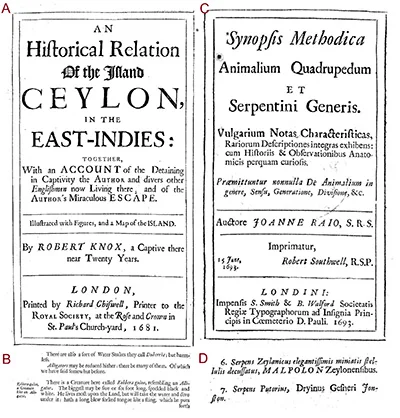 Perhaps the most frequently asked question Bandara encounters concerns the mighty Anaconda. While not a scientific name, the word itself is widely believed to be a corruption of the Sinhala Henakandaya, another snake name recorded in Ray’s listings of Sri Lankan reptiles.
Perhaps the most frequently asked question Bandara encounters concerns the mighty Anaconda. While not a scientific name, the word itself is widely believed to be a corruption of the Sinhala Henakandaya, another snake name recorded in Ray’s listings of Sri Lankan reptiles.
“What is remarkable,” Bandara reflected, “is that these words travelled across continents, entered global usage, and remained there — often stripped of their original meanings.”
For Bandara, restoring those meanings is about more than taxonomy. It is about reclaiming Sri Lanka’s rightful place in the history of science.
“With this study, three more Sinhala words formally join scientific nomenclature,” he said.
“Who would have imagined that a Sinhala word would be used to name a snake in Africa?”
Long before biodiversity hotspots became buzzwords and conservation turned global, Sri Lanka’s language was already speaking through science — quietly, persistently, and across continents.
By Ifham Nizam
Features
Children first – even after a disaster

However, the children and their needs may be forgotten after a disaster.
Do not forget that children will also experience fear and distress although they may not have the capacity to express their emotions verbally. It is essential to create child-friendly spaces that allow them to cope through play, draw, and engage in supportive activities that help them process their experiences in a healthy manner.
The Institute for Research & Development in Health & Social Care (IRD), Sri Lanka launched the campaign, titled “Children first,” after the 2004 Tsunami, based on the fundamental principle of not to medicalise the distress but help to normalise it.
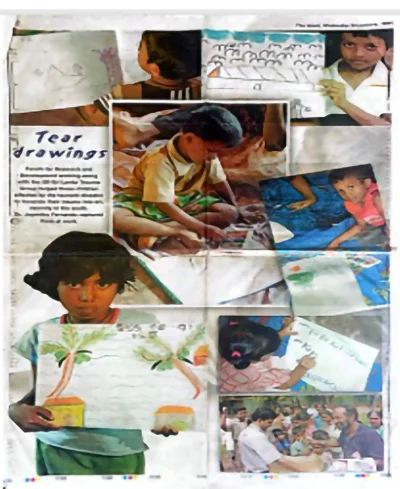
The Island picture page
The IRD distributed drawing material and play material to children in makeshift shelters. Some children grabbed drawing material, but some took away play material. Those who choose drawing material, drew in different camps, remarkably similar pictures; “how the tidal wave came”.
“The Island” supported the campaign generously, realising the potential impact of it.
The campaign became a popular and effective public health intervention.
“A public health intervention (PHI) is any action, policy, or programme designed to improve health outcomes at the population level. These interventions focus on preventing disease, promoting health, and protecting communities from health threats. Unlike individual healthcare interventions (treating individuals), which target personal health issues, public health interventions address collective health challenges and aim to create healthier environments for all.”
The campaign attracted highest attention of state and politicians.
The IRD continued this intervention throughout the protracted war, and during COVID-19.
The IRD quick to relaunch the “children first” campaign which once again have received proper attention by the public.
While promoting a public health approach to handling the situation, we would also like to note that there will be a significant smaller percentage of children and adolescents will develop mental health disorders or a psychiatric diagnosis.
We would like to share the scientific evidence for that, revealed through; the islandwide school survey carried out by the IRD in 2007.
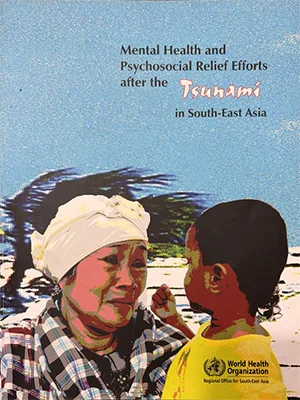 During the survey, it was found that the prevalence of emotional disorder was 2.7%, conduct disorder 5.8%, hyperactivity disorder was 0.6%, and 8.5% were identified as having other psychiatric disorders. Absenteeism was present in 26.8%. Overall, previous exposure to was significantly associated with absenteeism whereas exposure to conflict was not, although some specific conflict-related exposures were significant risk factors. Mental disorder was strongly associated with absenteeism but did not account for its association with tsunami or conflict exposure.
During the survey, it was found that the prevalence of emotional disorder was 2.7%, conduct disorder 5.8%, hyperactivity disorder was 0.6%, and 8.5% were identified as having other psychiatric disorders. Absenteeism was present in 26.8%. Overall, previous exposure to was significantly associated with absenteeism whereas exposure to conflict was not, although some specific conflict-related exposures were significant risk factors. Mental disorder was strongly associated with absenteeism but did not account for its association with tsunami or conflict exposure.
The authors concluded that exposure to traumatic events may have a detrimental effect on subsequent school attendance. This may give rise to perpetuating socioeconomic inequality and needs further research to inform policy and intervention.
Even though, this small but significant percentage of children with psychiatric disorders will need specialist interventions, psychological treatment more than medication. Some of these children may complain of abdominal pain and headaches or other physical symptoms for which doctors will not be able to find a diagnosable medical cause. They are called “medically unexplained symptoms” or “somatization” or “bodily distress disorder”.
Sri Lanka has only a handful of specialists in child and adolescent psychiatric disorders but have adult psychiatrists who have enough experience in supervising care for such needy children. Compared to tsunami, the numbers have gone higher from around 20 to over 100 psychiatrists.
Most importantly, children absent from schools will need more close attention by the education authorities.
In conclusion, going by the principles of research dissemination sciences, it is extremely important that the public, including teachers and others providing social care, should be aware that the impact of Cyclone Ditwah, which was followed by major floods and landslides, which is a complex emergency impact, will range from normal human emotional behavioural responses to psychiatric illnesses. We should be careful not to medicalise this normal distress.
It’s crucial to recall an important statement made by the World Health Organisation following the Tsunam
Prof. Sumapthipala MBBS, DFM, MD Family Medicine, FSLCFP (SL), FRCPsych, CCST (UK), PhD (Lon)]
Director, Institute for Research and Development in Health and Social Care, Sri Lanka
Emeritus Professor of Psychiatry, School of Medicine, Faculty of Medicine & Health Sciences, Keele University, UK
Emeritus Professor of Global Mental Health, Kings College London
Secretary General, International society for Twin Studies
Visiting Professor in Psychiatry and Biomedical Research at the Faculty of Medicine, Kotelawala Defence University, Sri Lanka
Associate Editor, British Journal Psychiatry
Co-editor Ceylon Medical Journal.
Prof. Athula Sumathipala
-

 News7 days ago
News7 days agoMembers of Lankan Community in Washington D.C. donates to ‘Rebuilding Sri Lanka’ Flood Relief Fund
-

 News5 days ago
News5 days agoBritish MP calls on Foreign Secretary to expand sanction package against ‘Sri Lankan war criminals’
-

 Features7 days ago
Features7 days agoGeneral education reforms: What about language and ethnicity?
-
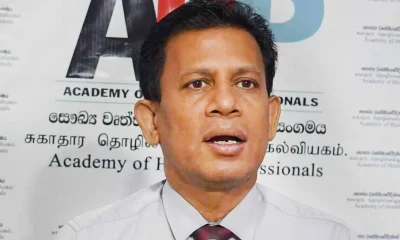
 News7 days ago
News7 days agoSuspension of Indian drug part of cover-up by NMRA: Academy of Health Professionals
-
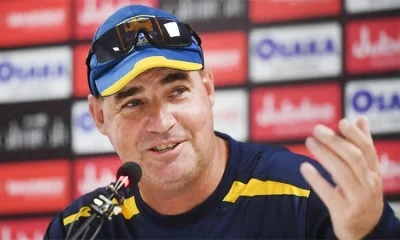
 Sports5 days ago
Sports5 days agoChief selector’s remarks disappointing says Mickey Arthur
-
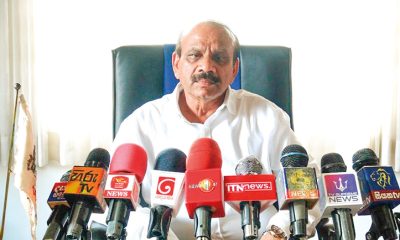
 News4 days ago
News4 days agoStreet vendors banned from Kandy City
-

 Editorial7 days ago
Editorial7 days agoA very sad day for the rule of law
-

 News7 days ago
News7 days agoUS Ambassador to Sri Lanka among 29 career diplomats recalled













